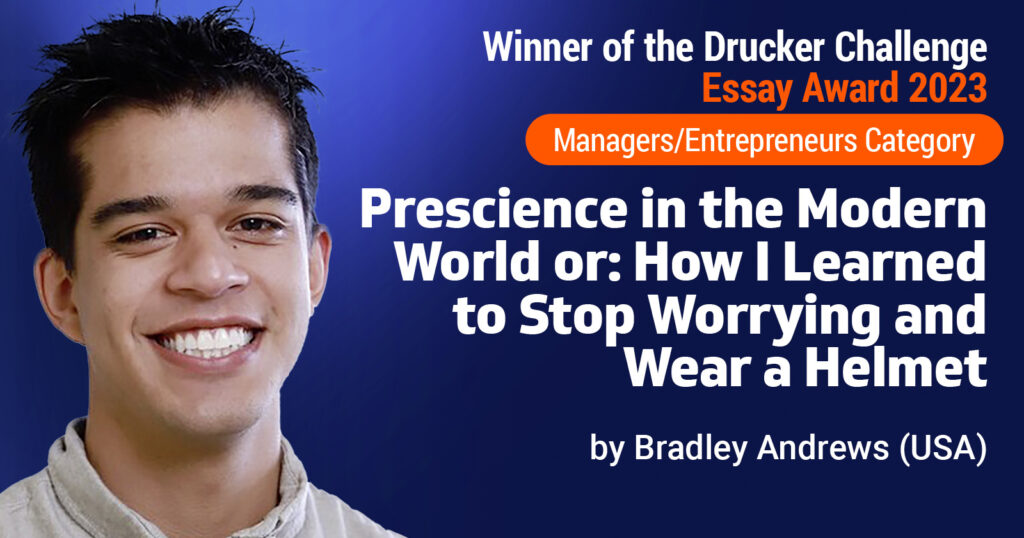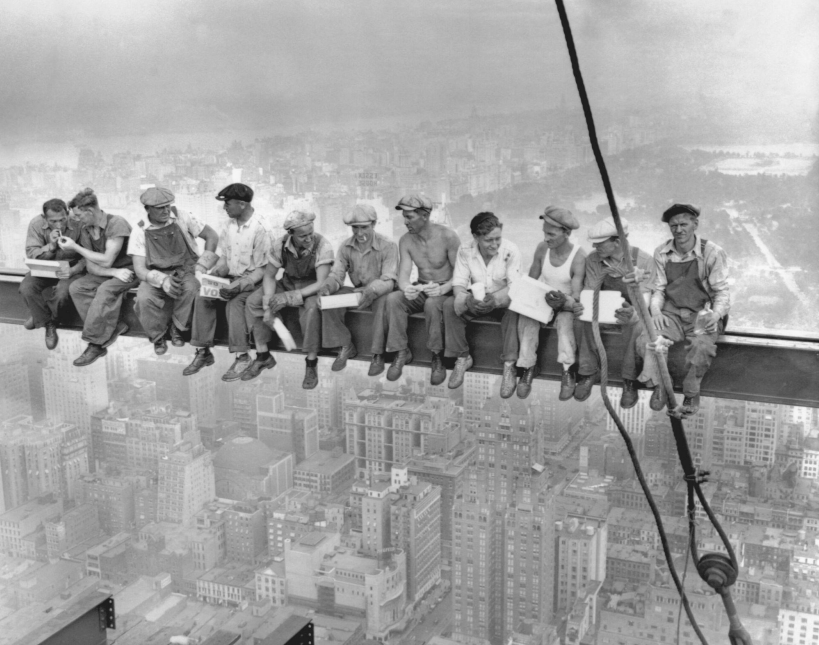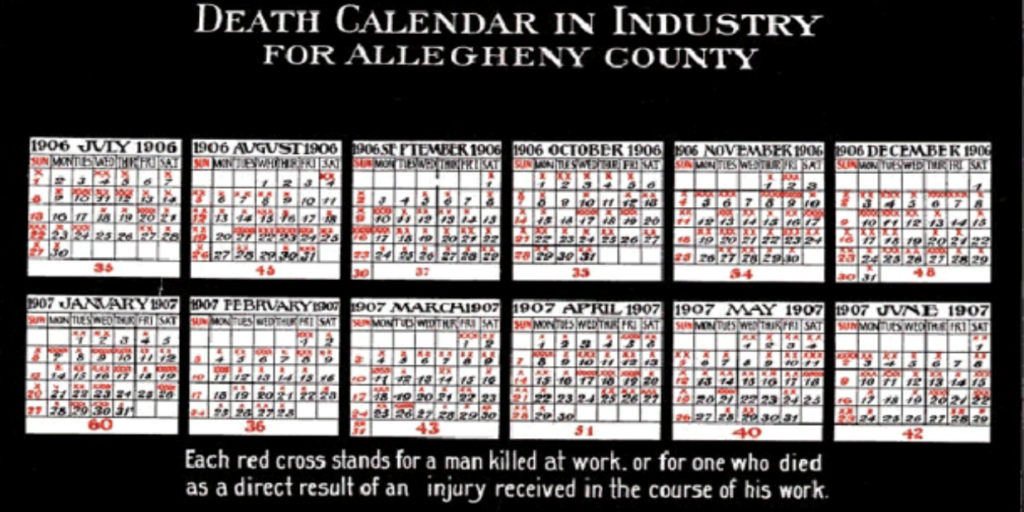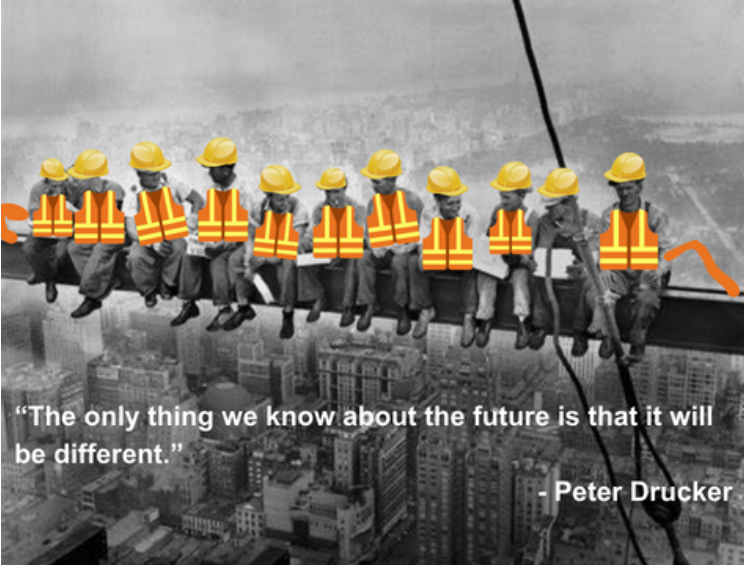
The velvet curtain is drawn aside and you survey the room nervously while entering. The space is small and dim, lit only by soft candles emitting subtle aromas of sage. There is more purple velvet tapered to the wall, this time laced with small golden trim and accented with intricate embroidery. The air is warm, but not stuffy, and something about it seems intentionally messy. In the middle of the room sits a crystal ball. It shines and shimmers like smoke as you walk towards the chair in the middle of the room which you assume is your seat. A man approaches the crystal ball, peers into it for a moment, and then lifts his eyes to meet your gaze. A smile like a chasm cracks across his face as he begins to speak…
“Welcome to our business strategy and forecasting session, are you ready to begin?”
We all have our own versions of a crystal ball. We all have our rituals and processes for making predictions, formulating strategies, and subduing the future to obey our whims. Yet strategy, if not tempered with humility, can easily become one of the greatest enemies of resilience. Predictions regarding the future are good, provided that you don’t believe in them. The moment that one commits too strongly to their own forecasts is the moment they have made their first step to becoming wholly un-resilient. This is because the future will always elude humans, despite the development and sophistication of our predictive tools. Obsession with a singular strategy, especially one thought to be particularly genius, is a mistake that has preceded many downfalls.
State-of-the-art business solutions have graduated from crystal balls, tea leaves, and bird bones. Yet, many executives still gather around the output of a Monte Carlo simulator to calm their commercial anxieties while others comb the matrixes of big data in an attempt to predict the next behavioral trend. Not even artificial intelligence and all of its computational prowess is able to liberate man from the effects of change. In fact, it
will only accelerate the speed and the frequency of upheavals. These tools are awe-inspiring, but it remains the responsibility of humans, specifically of leaders and those with the privilege of influence, to navigate change. More than navigate, I suggest that our responsibility is to befriend change and conduct ourselves in a way that respects how it indiscriminately gives and takes away.
This concept saturated Peter Drucker’s life and teachings. In his classic book Age of Discontinuity, Drucker optimistically warned about the shortening expiration dates that contemporary solutions were carrying for future challenges.1 In a 2004 interview with A.G. Lafley, Drucker and Lafley discussed four choices every manager is faced with when change happens:
“Your first choice is to try to resist it, second choice is to ignore it. I think both of those choices are really bad choices. And the third choice, what I am really for, third choice is to try to adapt to it, to react to it. And the fourth choice is to be proactive and try to influence the course of the change so it will make a positive impact on your industry or enterprise. To lead change.”2
Perhaps one exception to the law of change is the timelessness of Drucker’s thoughts. These sentiments have only grown in relevance since the time of their initial writing. Disruption is no longer an unavoidable event that we unhappily adjust to, it is an expected element of organizational life. Even if we do not know where the disruption will come from, we pre-accept that pivots will need to take place. Even in the 21st century, there is no such thing as free lunch. Contests with chaos are the recurring subscription cost that any manager must pay to persist in their field. Armed with this awareness, a wise leader can posture his or her organization in a way that uses disruption as a launch pad for improvement. Statistician and NYU professor Nassim Nicholas Taleb calls this unique quality antifragility. In his book of the same title, he describes what this term means:
“Antifragility is beyond resilience or robustness. The resilient resists shocks and stays the same; the antifragile gets better. The antifragile loves randomness and uncertainty… I’d rather be dumb and antifragile than extremely smart and fragile, any time.”3
Taleb goes on to highlight various examples of antifragility, such as the human immune system or muscular system. In both cases, resistance to the system’s purpose causes the system to evolve and strengthen the means by which it accomplishes its mission. For muscles, this evolution is the creation of new muscle fibers. For the immune system, it’s the organic invention of new cells that fight off foreign contaminants. Using the framework of antifragility, we see a potential improvement to the concept of merely bouncing back to baseline. Instead, we picture an organization that bounces beyond the baseline. An antifragile corporation is one that can use resistance and setback as fuel for jettisoning them above the status quo. Conflict is transmuted into the catalyst for growth.
However, even the framework of antifragility does not encompass the most radical form of resilience. In Taleb’s view, antifragile systems evolve to be better suited for a specific purpose. They develop their means, but the ends remain the same. This begs the question, “what happens when the disruption causes a change to the ends?” Or, “what does a system do when a new aim is introduced that conflicts with the existing ones?”
Peter Drucker acknowledged the existence of this phenomena and discussed it in The Post Capitalist Society. He stated “It is the very nature of knowledge that it changes fast and that today’s certainties will be tomorrow’s absurdities.”4 This is a deceptively deep thought and I have discovered its truthfulness both professionally and personally.
When I discovered at 23 years old that the man who had raised me was not my father, my self-knowledge became instantly absurd. The story of my birth had been surreptitiously concealed by certain family members and the way in which I discovered this truth was deeply traumatic. In a single instant, I was dislocated from the previous reference points I had for myself. My skin color, which is much darker than my brothers’ and had been the punchline of many jokes, now had new relevance. Moments of mismatch with my family’s culture or vague senses of being a misfit now had an explanation. I was technically the same individual and the most fundamental elements of my personality remained intact, but this new knowledge changed the landscape of my reality. The truths which I had previously used to orient myself had been irrevocably altered. Like all difficulties, this situation contained both great pain and great promise. Provided that I could healthily mourn the loss of my old identity, I had the freedom to forge a new one. I had the freedom to find new meaning for myself and to integrate new purposes that were released from the constraints of yesterday.
Individuals are not the only entities placed in the position of needing to redefine both their self-efficacy and their mission. It happens to institutions and industries also. Seven months ago I moved to New York City and joined a consultancy that oversees the development and construction of the Big Apple’s most iconic landmarks, such as Grand Central Station, Times Square, Bryant Park, and more. Physicist George West explains in his book Scale that cities are far more resilient and long-lasting than families, companies, or even governments.5 With this in mind, I observed my new environment with keen interest and was frequently reminded of one of NYC’s most famous pictures.

This photo was taken in 1933 and is unimaginatively titled “Lunch Atop A Skyscraper.” Its fame is not just because it is aesthetically pleasing, but because of the tangible cool that these workers exude. The laissez-faire aura that these blue-collar workers exhibit whilst hovering hundreds of feet above the average citizen is potent. Upon viewing, one immediately feels that they are the true kings of New York City. They have built Babel and conquered the heavens.
The truth is, reality differed drastically from the photo. “Lunch Atop A Skyscraper” is not a candid snapshot, but a staged marketing ploy conjured up by some Madison street marketer and the owner of the 30 Rockefeller building. The identities of the workers are unknown, but the odds that they lived long and healthy lives were not favorable. Until at least the 1970’s, things like safety harnesses on skyscrapers were not seriously enforced and there was no incentive to wear personal protective equipment in construction zones nor to be mindful of hazardous materials. A veteran colleague was recently telling me about the early days of his career, when he and his crew would tear down walls packed with asbestos and no thought of wearing a mask. One astonishing illustration of the danger of historic construction work can be seen in the history of Allegheny County, Pennsylvania. In 1906, 526 construction workers died from the work in Allegheny County alone.6 That is over 10% of the annual number of workplace deaths that currently occur in all industries, in all states, across modern America.7

These workers were certainly brave, but they were still sacrificed for the sake of quick and profitable industrial progress. Eventually, it became apparent that work solely guided by the aims of speed, profit, and progress was not optimal. The NYC construction industry, known for its sexy, rapid, and borderline reckless expansion,
would have to become intrinsically less sexy and less rapid, in order to also become compassionate. It would have to pivot from seeing workers as a means of production, to seeing the workers as ends in and of themselves. Integrating a new objective such as this one would necessarily transform the hard-ingrained habits of the industry. Fast forward to 2023, and every construction job is preceded by meticulously derived safety plans, implemented by qualified safety managers, and ruled by guidelines that are reinforced by multiple agencies. The sort of hazardous activity mentioned by my colleague is unconscionable to any modern construction manager and protecting your people is esteemed as the paramount quality of an honorable leader. Do the perpetual checks and balances, submissions and reviews, or prolix safety plans sometimes stall the work? Absolutely; but bureaucracy is itself an invitation for innovation and I would rather be frustrated with a living pencil pusher than mourning the death of a flattened engineer.
From the ivory towers of modern knowledge workers, it’s easy to relegate this phenomena as an artifact of a time where people were less intelligent. Yet, this narrative incorrectly assumes the superior intellect of modern people and fails to appreciate how the market does not make these kinds of changes mandatory. There are countless contemporary examples where concern for one’s neighbor is outpaced by the desire for scientific progress or the promise of lucrative financial gain. In a purely self-interested commercial environment, there is no inherent incentive for upper managers to implement guidelines that reduce the rate of production, even if it is more ideal for blue collar workers. Since there was no fancy tech, groundbreaking algorithm, or science-fiction inspired advancement, the sort of transformation that the construction industry underwent is easily glossed over. Consider how the individuals most affected by the unsafe working environment of old New York never got a chance to become advocates for improvement. There is no “bouncing back” from a 600 foot fall. Therefore, it was not the workers who necessarily gained in resiliency, but the system itself. The ecosystem got smarter. These changes are a sort of internal self-disruption resulting in new functions. The collective group birthed a new priority and a new end, ex nihilo. It did not happen overnight, but slowly and over time a new systemic identity with an augmented culture was forged. A culture with a more noble mode of being.
In my estimation, this is the promise of a much more subversive and exciting form of resilience. A resilience that is not just agile in the means it uses to achieve its end, but revolutionary about the ends themselves. This is the best and time-tested way to create long-term impact. More importantly, it is necessary to create a type of impact that is still seen as positive after fifty, one hundred, or a thousand years. In a purely agile model, speed is employed as a method to gaining first mover advantage, but sometimes at the cost of comprehensiveness. This tradeoff is tempting and, admittedly, sometimes pays off. Jeff Bezos has often attributed Amazon’s astronomical success to the advantage of having their first seven years being almost entirely competition-free. Yet, this is an outlier experience, not a foolproof strategy. I remember being troubled by an interview that David Rubenstein had conducted with Bezos for the Washington Economic Forum.8 Bezos states, “People will stop me and say ‘congratulations on your quarter’ and I say ‘thank you,’ but what I am really thinking is ‘that quarter was baked three years ago.’ Right now I am working on a quarter that’s going to reveal itself in three years sometime. That’s what you need to be doing, you need to be thinking out two to three years in advance.” My profound discouragement was equal to how impressive Bezos was to me. Being able to strategize three years out required a knack for prediction that I simply did not have, not to mention a type of influence in my organization that far exceeded my formal position at the time. Yet, it turns out that even the world’s once richest man was not as prophetic as he thought himself to be. This interview was conducted in late 2019, and his plans, like all of our plans, were reduced to rubble in just a few months.
So why am I impressed with the concept of a company that can birth new ends, and not just new means? I am convinced that it is a necessary attribute for the organizations of the future. We have already seen a vast shift in consumer preference for brands that can hold this tension of having multiple purposes and multiple values. This is the byproduct of a culture that has grown an insatiable appetite for hyper interconnectivity. Not that long ago, people were ignorant of the events taking place outside their immediate field of vision, but now have instantaneous access to the daily activity of millions of people on the other side of the world. Devices are no longer dedicated to doing one thing, but expected to have multiple capabilities. Hybrid and work-from-home
models of work mean that the office, house, recreation, and vacation are mingled indistinguishably. Even Marvel films (the highest grossing productions of our day) are compelled to include dizzyingly complex crossovers of characters, storylines, timelines, multiverses, and genres. The boundaries between traditional categories have dissolved and multitudes of mixed input and output are the norm for the modern person. Why
would it be any different for organizations?
Many of us are already in the penumbra of this phenomenon. Customers want their brands to provide good products, but to also be sustainable, racially-conscious, vocal about climate change, ethically sourced, etc… Pursuit of these causes often compete with the classic goal of companies, such as making a high profit and reducing overhead. Companies may not have to advocate for any of these causes specifically, but companies must be able to integrate additions to their business goals, even if the additions seem superficially contradictory. More importantly, they have to do it authentically and not as mere virtue signals. To draw on my previous anecdote: it is the difference between projecting the appearance of a safe company versus being sincerely concerned for the wellbeing of the workers. It is the difference between seeing injuries as obstacles to efficiency versus protecting workers because they are more important than efficiency.
Executives, managers, strategists, and forecasters will never be able to completely escape the tyranny of the future. It will always beset us with the unexpected, the shocking, and the absurd. However, if we surrender our attempts at controlling fate, we may be able to become partners with it. I am not asserting that the solution for every disruption is to rewrite your mission statement nor do I wish to create false dichotomies between the various kinds of strategies, each of which are applicable in different seasons. Rather, my hope is to emphasize a posture of openness that exceeds mere utilitarian agility. Incorrect assumptions about the future can obstruct us from success, but so can our assumptions about what success is. Resiliency becomes a liability when resiliency leaves no room for imagination. It does so by squeezing out the consideration of alternative forms of flourishing. This consideration is the key ingredient to producing a reality that holds the tension between seemingly incompatible or paradoxical goals. Knowing how to materialize this reality, especially when it was previously inconceivable, is the very definition of creativity. This unique attribute is the birthright of human beings – not of machines, computational models, or magic objects. Preservation of this creative imagination requires constant revision and examination of our aims. These aims, and the people we pursue them with, are the armaments we carry into tomorrow’s struggle. In a sense, the crystal ball of the opening parable does reveal the solution to tomorrow’s woes. When held up to the light, and closely inspected, a crystal ball yields your own reflection.

About the author:
Bradley Andrews (USA) Bradley is a young professional who lives and works in Manhattan, NYC. He is passionate about developing human-centric organizations that use cutting-edge business practices to benefit the world. When he isn‘t working, you can find him at the Museum of Modern Art, playing soccer, or hunting for the city‘s tastiest bagel. Explore more of his thoughts on https://prolix.substack.com/
References :
1: Drucker, Peter F. 1970. The Age of Discontinuity. Routledge Books.
2: “Peter F. Drucker ‘A Thoughtful Conversation’ Transcription Documents, Part 2.”
November, 2004. https://ccdl.claremont.edu/digital/collection/dac/id/7749/rec/1.
3: Taleb, Nassim Nicholas. 2012. Antifragile: Things That Gain from Disorder. https://ci.nii.ac.jp/ncid/BB11522370
4: Drucker, Peter F. 1993. Post-Capitalist Society. Routledge Books.
5: West, Geoffrey B. 2017. Scale: The Universal Laws of Growth, Innovation,
Sustainability, and the Pace of Life in Organisms, Cities, Economies, and Companies.
Penguin.
6: “Achievements in Public Health, 1900-1999: Improvements in Workplace Safety —
United States, 1900-1999.” 1999. June 11, 1999. Achievements in Public Health,
1900-1999: Improvements in Workplace Safety — United States, 1900-1999 (cdc.gov)
7: “Death on the Job: The Toll of Neglect, 2022 | AFL-CIO.” 2022. April 26, 2022.
https://aflcio.org/reports/death-job-toll-neglect-2022#:~:text=340%20workers%20died%
20each%20day%20from%20hazardous%20working,of%20dying%20on%20the%20job
%20than%20all%20workers.
8: The Economic Club of Washington, D.C. 2018. “Jeff Bezos, CEO and Founder,
Amazon.” https://www.youtube.com/watch?v=zN1PyNwjHpc.

